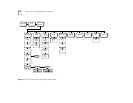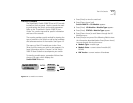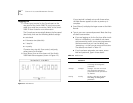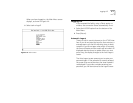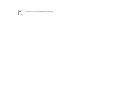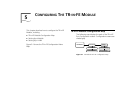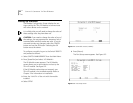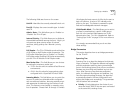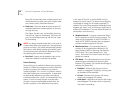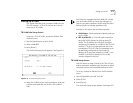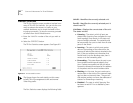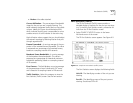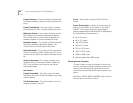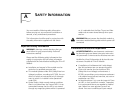
5-4 CHAPTER 5: CONFIGURING THE TR-IN-FE MODULE
Ports with a lower value have a higher priority and
will be blocked only after ports with a higher value
and a lower priority have been blocked.
■ Path Cost—Path cost determines the amount of
overhead required to forward packets to the root
through this port.
The higher the path cost, the less likely Spanning
Tree will use a port for forwarding. The lower the
cost, the more likely Spanning Tree will use a port
for forwarding.
NOTE: It is always recommended that, in the case of
a loop formed with a low speed port, the high-speed
ports do not block. The switch automatically provides
this function with default settings (port speed is part
of the spanning tree calculations). Be aware of this, if
the spanning tree values are modified.
■ Fast Fwd—Frames are forwarded as soon as the
destination address is received and verified.
Source Routing
Source Routing is a method of allowing a ring station
(node) on a Token Ring network to communicate with
another ring station on a different ring intercon-
nected by bridges. The “source” ring station, which is
the node initiating the communication, is responsible
for dynamically determining and then maintaining
information about the “route” to the destination ring
station. A route is simply the path a packet takes
through a source route bridged network from the
source ring station to the destination ring station.
In the case of TR-in-FE, a virtual LAN ID must be
assigned to the FE cloud. This allows Source Routing
to proceed as though the FE media supported TR
natively. The entire FE transparently forwarded cloud
appears as a single “ring” and hence a single hop to
attached TR endstations. This also allows FE servers to
participate in source routing.
■ Attached Lan Id—A unique number that identi-
fies the segment to which the port connects. This
value can be set between 0 and FFF (0-4095). A
value of FFFF (65535) indicates that no segment
number has been assigned to this port.
■ Max Route-Desc—This value describes the
number of routing descriptions allowed in All
Route Explorer (ARE) or Spanning Tree Explorer
(STE) frames. This is also referred to as “hop
count” limit since it limits the number of rings a
packet can traverse.
■ STE Mode—This value determines how this port
responds when presented with Spanning Tree
Explorer (STE) packets. Set the field accordingly by
pressing the [Space Bar].
■ Disabled—Indicates that the port will not
accept or propagate STE packets, and any pack-
ets received will be discarded.
■ Forced—Indicates that the port will always
accept and propagate STE packets.
■ Auto-Span—Indicates that the port will accept
and propagate STE packets when its Spanning
Tree state is forwarding.



